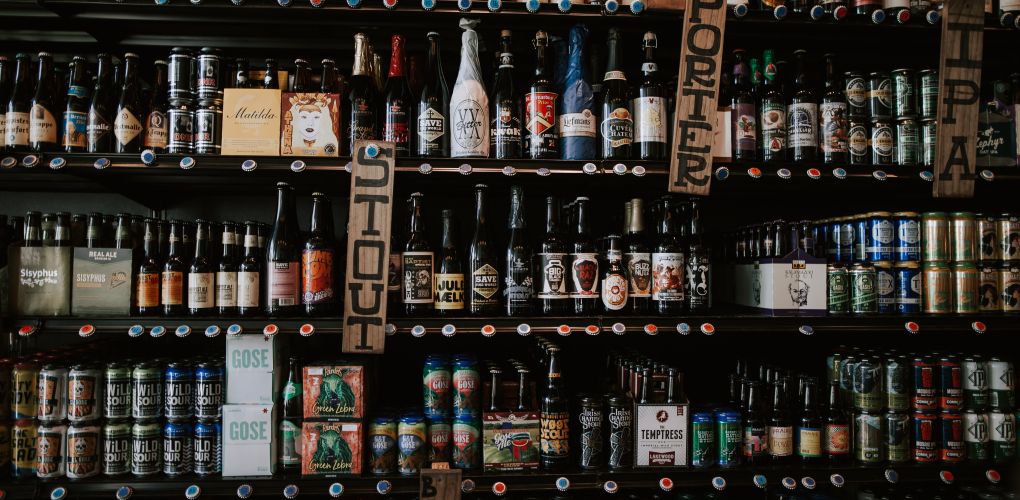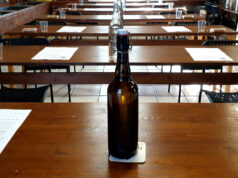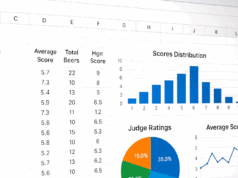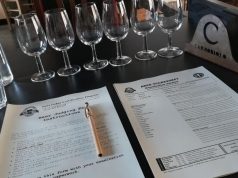I am still struggling with all the BJCP Written Exam stuff that I have to memorize for the exam, which is going to be next October, the 15th. A lot of people think that this written assessment is a nerdy ordeal, with a lot of stuff to learn by heart just to get a good grade and then forget all about it in a few days.
That is partly true, but it’s not the whole story. It was in fact what I had been thinking before getting down with the studying, but as long as I delved more into it, my opinion on the matter slowly changed.
Let’s start from the most challenging part: the style parameters.
[SPOILER: my score was a stunning 93/100! More on that here]
THE STYLE PARAMETERS QUESTION
In this post I will focus on the parameters in the two styles-related questions of the Written Exam. Each of this two mini-essay questions awards 15% of the 100 points you could get on each answer. It does not seem much, but if you consider the overall exam 100 score span, you could get up to 6 points out of 100 (3 per each style-related question) answering these two 15% sub-questions.
If you get them almost right, which is not that difficult since you have to know each style inside out anyway, you can gather 2-3 precious points. That could make the difference between remaining a Certified judge or stepping up to the National rank.
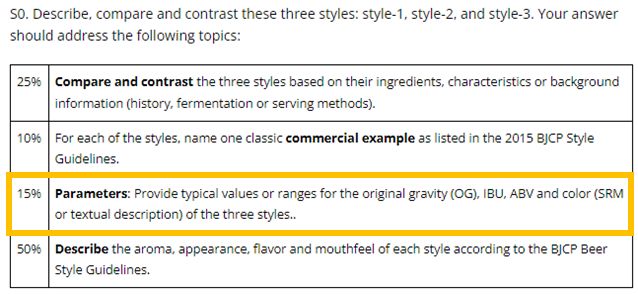 From what I gathered, this parameters part of the question was added sometime along the way, it was not on the first Written Exams. I know that a lot of BJCP people are asking to take that out of the exam again. They make the point that learning these numbers by hearth is useless since you can always refer to the manual during beer judging or anytime you’d need it (not during the exam, of course).
From what I gathered, this parameters part of the question was added sometime along the way, it was not on the first Written Exams. I know that a lot of BJCP people are asking to take that out of the exam again. They make the point that learning these numbers by hearth is useless since you can always refer to the manual during beer judging or anytime you’d need it (not during the exam, of course).
Al Boyce, in his famous (and greatly debated, from what I heard) guide to the Written Exam, states that writing a single number for each style parameter should be enough to get at least some points from this part of the style-related question.
In the exam (see picture above) they indeed ask to write “a range” or “typical values” for each parameter. So it seems that writing just an average number for each one should be enough. But would it be enough to get the full 3 points for each question? I don’t know, actually, but I think it wouldn’t.
Anyway, I think that remembering at least the ABV ranges for each style is a worthwhile endeavour, not just a specific mechanical task to increase the exam score.
FOCUS ON THE ABV
Remembering an ABV range, compared to just an average ABV number, reveals a deep style knowledge in my opinion.
Saying that an Old Ale has an average ABV of 7.25% does not tell the whole story about this style. The fact that the ABV of an Old Ale can span between 5,5 and 9% ABV tells a lot more about it. It could be a session beer but also a sipper, this unfolds a new scenario which is also useful while describing the style in more detail, later in the answer.

What I am trying to say is that knowing the ABV range of the beer is important to get a first glimpse of the style. The ABVs are guiding me through making better connections between styles.
Think about the links between an Irish Stout (3,8-5,0% ABV), an Irish Extra Stout (5,0-6,5% ABV) and a Foreign Extra Stout (6,3-8%ABV). They cover a whole range, with increasing strength and complexity along the way. Even if the FES is not part of the Irish Beer styles in the guidelines, it does share some important features with the Irish ones, like bold roastiness and a firm bitterness.
Similar story with Munich Helles, Helles Bock and Doppelbock.
Memorizing ABV finally fixed into my mind that Belgian Pale Ales are session beers, a rarity for the Belgians. The ABV range is tight (4,8-5,5% ABV) and unusually low for Belgian beers. In fact, they actually are more British than Belgian in certain ways.
That is: memorizing ABVs is actually helping me a lot at memorizing styles in general.
And what about the other parameters, like OGs, IBUs and SRMs?. That is too much stuff to memorize. Yeah, I know. But there’s a way to get around that.
SRMs ARE ALREADY IN YOUR HEAD
Well, SRM are already in the style description that you have to know anyway. Writing the color range in the appearance section is just translating SRM numbers into words. So you already know them, you just have to translate words in numbers. Not that difficult.
I am using a boiled down colour table, along which I can navigate with no difficulties adding quantitative adjectives like deep, dark or pale. 18 SRM ? Deep Copper. 7 SRM? Light Amber (or Deep Gold). Easy peasy.
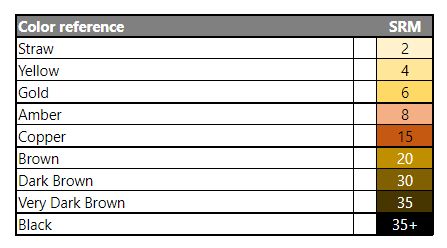
EDUCATED GUESS ON OGs AND IBUs
To calculate OGs and IBUs, I start from the ABVs. Lower OGs are usually really close to ABVs in beers with standard attenuation. So, if you have a beer with a lower range of 4.5% ABV, like, say, a Belgian Pale Ale, the OG would be roughly 1.045 (it is actually 1.048, but it is close enough I reckon). When you get over 7,0% ABV, the OG translates into something 3 to 5 point less than the ABV.
So, for example, 7,5% ABV should translate roughly to a 1,070 OG with a standard attenuation.
You can tune this relationship by considering the attenuation of the beer, which is something that you should already know. For example, Tripels have high attenuation, so the upper ABV of 9.5% translates into a 1.085 OG.
While learning this numbers, I also found some weird dynamics in some BJCP parameters. Look a the Tripel parameters below (from the 2021 guidelines).

With those OG and FG ranges there’s no way to get a 7.5 ABV% Tripel (try it yourself with this tool). With the minimun OG (1.075) it should go up to an FG of 1.017 to get 7.5% ABV, which is out of range (for a good reason: tripels are dry). So, I think (but I could be wrong) that the minimum OG for this style is too high. In fact, is in line with the 7.5% ABV which does not match with what I said before about styles with high attenuation and ABV higher than 7.0%.
But anyway.
Now to the IBUs. I simply use IBU/OG ratios. They are far less spread than IBUs themselves, because IBU/OG ratios usually span from 0 to 1 (0.1, 0.2, 0.3 … 1). Not that difficult to remember. When you interiorize the style descriptions, it is easy to guess the average IBU/OG ratio: Bocks 0.3, IPAs 0.9, Bitters 0.7, Tripels 0.3. It is not super accurate, but it gets you close enough for most styles. Simple calculators can be used during the exam, so multipling numbers should not be a problem.
Usually the IBU/OG ratio is a tad lower at the lower end of the range and a little higher at the higher end, to balance out the residual sweetness.
TO SUM UP
Memorizing styles parameters is a pain in the ass. I know. But it is not completely useless. It can help better understanding beer styles.
You can get some precious points at the exam making an effort, without memorizing all the possible ranges. SRMs are already there in the style description. Just memorize ABV ranges (it is difficult, but not impossible) and try guessing OGs and IBUs from your knowledge of the style attenuation (that you should know as well).
Reducing it all to writing a single typical value for each parameter it’s obviously easier, but I don’t know if it gets you the same scores. In my humble opinion ranges show more dept of knowledge, even if they are not totally accurate. A single value is far easier to guess (there are more than half of the styles for which a 5% ABV would be in the correct range) but doesn’t tell the whole story.
Your choice.
MY TOOL
To help me test my knowledge, I made a random style picker with an Excel worksheet. It picks a random style among the 83 which feature in the exam style triplets, and checks your answers.
You can assign a “deviation” which is acceptable to you (I have no idea how the graders evaluate this section). To me a 0.3 ABV deviation and a 3 SRM, OG and IBU deviation are fine. If I got all the four ranges within these deviations, I am satisfied. I hope to get at least 3 or even 4 points from this answer, which are gold.
I also added a typical commercial example for each style, which can get you 4 additional points on the overall 100 exam score. Not bad at all.

